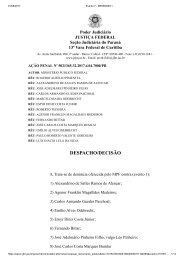Brasil só deve dominar Leitura em 260 anos, aponta estudo do Banco Mundial Relatorio Banco Mundial _Learning
You also want an ePaper? Increase the reach of your titles
YUMPU automatically turns print PDFs into web optimized ePapers that Google loves.
program completion. 91 Student success courses are<br />
usually stand-alone, credit-bearing courses for new<br />
students that <strong>em</strong>phasize the <strong>deve</strong>lopment of study<br />
skills. Experimental evidence from the United States<br />
shows promising results on participants’ number of<br />
credits earned, classes passed, and class standing. 92<br />
Finally, recent <strong>deve</strong>lopments in self-directed technology<br />
models are opening new opportunities for youth<br />
to work independently to meet their learning needs<br />
and upgrade their skills, but this r<strong>em</strong>ains a new area<br />
for r<strong>em</strong>edial education research, and evidence on<br />
their impacts is still sparse. 93<br />
Notes<br />
1. UNICEF, WHO, and World Bank (2016).<br />
2. Hungi (2010).<br />
3. Cunha and others (2006).<br />
4. Black and others (2008); Horton, Alderman, and Rivera<br />
(2008); Thompson and Nelson (2001).<br />
5. Coe and Lubach (2007); Garner and others (2012).<br />
6. Center on the Developing Child (2016).<br />
7. Walker and others (2007).<br />
8. Bendini (2015).<br />
9. Black and others (2017).<br />
10. Bradley and Corwyn (2005); McCoy and Raver (2014);<br />
Shonkoff and others (2010).<br />
11. Farah and others (2006); McLoyd (1998).<br />
12. These numbers likely overestimate global preschool coverage<br />
because many low-income countries <strong>do</strong> not report<br />
access data (Save the Children 2017).<br />
13. Black and others (2017).<br />
14. Devercelli, Sayre, and Denboba (2016).<br />
15. ACPF (2011).<br />
16. Berlinski and Schady (2015).<br />
17. Naudeau and others (2011).<br />
18. Black and others (2017). This is likely an underestimate<br />
of the true number of young children who are at risk of<br />
not reaching their <strong>deve</strong>lopmental potential, given the<br />
multiple risk factors associated with poverty.<br />
19. Bhutta and others (2013); Britto and others (2016).<br />
20. Galasso and Wagstaff (2016).<br />
21. Galasso and Wagstaff (2016); Skoufias (2016).<br />
22. Eilander and others (2010); Horta, Loret de Mola, and<br />
Victora (2015).<br />
23. Galasso and Wagstaff (2016).<br />
24. Almond and Currie (2011); Baker-Henningham and<br />
López Bóo (2010).<br />
25. Aboud and Yousafzai (2015); Britto and others (2016).<br />
26. For a review, see World Bank (2015).<br />
27. Britto and others (2016); World Bank (2015).<br />
28. Denboba and others (2014).<br />
29. Rahman and others (2013).<br />
30. Berlinski, Galiani, and Gertler (2008); Engle and others<br />
(2011); Favara and others (2017); García and others (2016);<br />
Rao and others (2014).<br />
31. Bouguen and others (2013); Rosero and Oosterbeek<br />
(2011).<br />
32. Martinez, Naudeau, and Pereira (2012); Nakajima and<br />
others (2016).<br />
33. However, center-based care can have the important added<br />
benefit of increasing labor force participation or further<br />
skills acquisition among parents, especially mothers.<br />
34. Attanasio and others (2014); Denboba and others (2014).<br />
35. Britto and others (2016).<br />
36. Richter and others (2016).<br />
37. Devercelli, Sayre, and Denboba (2016).<br />
38. Serneels and Dercon (2014).<br />
39. Oketch, Mutisya, and Sagwe (2012).<br />
40. World Policy Analysis Center (various years).<br />
41. Foko, Tiyab, and Husson (2012).<br />
42. Al-Samarrai and Zaman (2007); Bold, Kimenyi, and Sandefur<br />
(2013); Deininger (2003); Grogan (2009); Lucas and<br />
Mbiti (2012); Nishimura, Yamano, and Sasaoka (2008).<br />
43. Morgan, Petrosino, and Fronius (2012); Zuilkowski,<br />
Jukes, and Dubeck (2016).<br />
44. Duflo, Dupas, and Kr<strong>em</strong>er (2017); Kr<strong>em</strong>er, Miguel, and<br />
Thornton (2009).<br />
45. Filmer and Schady (2008); Fiszbein and Schady (2009).<br />
46. J-PAL (2013).<br />
47. Avitabile and de Hoyos (2015); Jensen (2010); Loyalka and<br />
others (2013); Nguyen (2008).<br />
48. Beaman and others (2012); Jensen (2012).<br />
49. Akresh and others (2012); Garg and Morduch (1998);<br />
Parish and Willis (1993).<br />
50. Akresh, de Walque, and Kazianga (2013).<br />
51. Avitabile and de Hoyos (2015); Barrera-Osorio and Filmer<br />
(2013); Nguyen (2008).<br />
52. Valerio and others (2016).<br />
53. Zuilkowski, Jukes, and Dubeck (2016).<br />
54. Benin: Blimpo (2014); Kenya: Kr<strong>em</strong>er, Miguel, and<br />
Thornton (2009); Mexico: Behrman and others (2015).<br />
55. Fryer (2011); Levitt and others (2016).<br />
56. The primary completion cohort is approximated by<br />
estimating the net intake rate to last grade in primary,<br />
and the lower secondary completion rate is modeled as<br />
a function of three components: primary completion<br />
rate, effective primary-to-lower-secondary transition<br />
rate, and net intake rate to last grade in lower secondary.<br />
The regional upper secondary completion rates are estimates<br />
from UNESCO’s World Inequality Database on<br />
Education (WIDE 2017), and the global upper secondary<br />
completion rate estimate is based on UNESCO’s 2015<br />
projection (UNESCO 2015).<br />
57. OECD (2016); Roseth, Valerio, and Gutiérrez (2016).<br />
58. Low proficiency is defined as level 1 and below on<br />
OECD’s Programme for the International Assessment<br />
of Adult Competencies (PIAAC) and the World Bank’s<br />
Skills Measur<strong>em</strong>ent Program (STEP) literacy assessments,<br />
and indicates limited understanding of basic<br />
texts. Medium to high proficiency is defined as level 2<br />
There is no learning without prepared, motivated learners | 123








